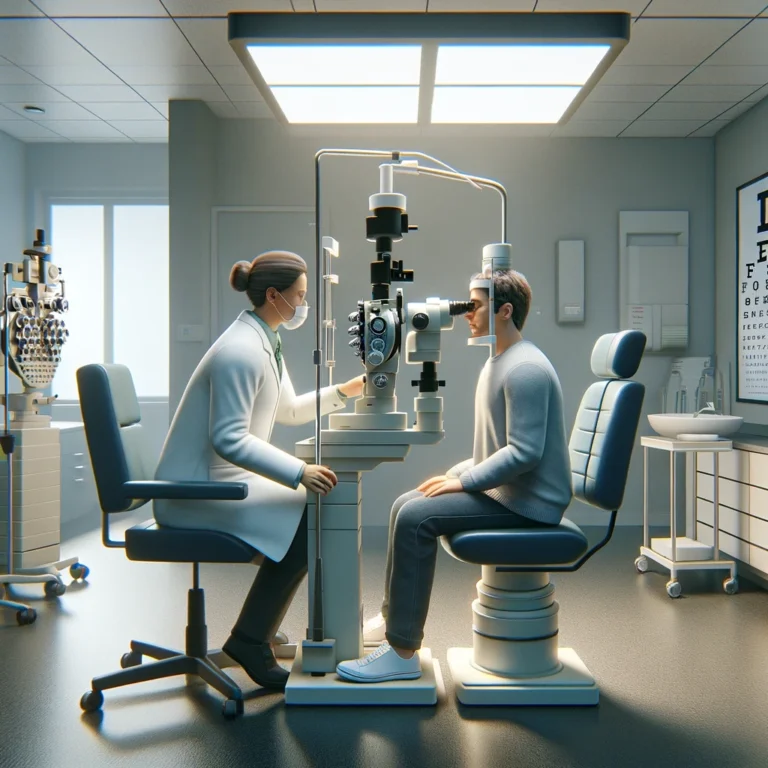

by Dr Diane Mueller – Are you dealing with sudden vision changes or pesky eye symptoms that just won’t quit? Buckle up, because we might be taking a detour into Lyme disease eyes territory. Yep, that tick-borne illness caused by the sneaky Borrelia burgdorferi bacteria.
Lyme isn’t just about rashes and feeling like a zombie – it can also do a number on your eyes. We’re talking conjunctivitis and light sensitivity in the early stages, and some serious stuff like uveitis and optic neuritis down the line.
We have helped thousands of people restore their health and quality of life by diagnosing and treating Lyme Disease
Lyme disease, from Borrelia burgdorferi bacteria, can impact your eyes, causing everything from conjunctivitis and light sensitivity to uveitis and optic neuritis.
About 10% of Lyme patients get ocular symptoms like redness, discomfort, and blurry vision. In later stages, we’re talking inflammation with vitritis, uveitis, and neuroretinitis.
Lyme’s stages affect your vision. Early on, you might be rocking some photosensitivity and floaters. But as this disease progresses, it can cause some real trouble like uveitis and optic neuritis. We’re talking pain, redness, light sensitivity, blurred vision, and even vision loss.
Lyme-related eye symptoms fall into different categories. Some, like conjunctivitis and light sensitivity, show up early. But the real issue starts later with inflammation and vision loss.
Optic Neuritis, Retinal Vasculitis, and Photophobia are just a few of the eye conditions linked to Lyme. Early detection and treatment are key to keeping your eyes in good shape.
Want to keep Lyme away from your eyes? Cover up, use repellents, get regular check-ups, and catch this disease early. Your eyes will thank you
Lyme disease just loves to explore, and your eyes are no exception. This sneaky disease can cause all sorts of ocular complications, ranging from mild discomfort to some serious visual impairments.
Lyme’s ocular shenanigans come in both early and late flavors. Studies show that around 10% of Lyme patients also deal with a nonspecific follicular conjunctivitis early on. Think red, irritated eyes with some gunk thrown in. On the flip side, keratitis often shows up within months, giving your eyes that trendy cloudy, white-hazy look.
But wait, there’s more! Intense inflammatory syndromes like vitritis and uveitis can also crash the party, messing with the inner and middle parts of your eye. In some cases, you might even need a vitreous tap to get a diagnosis. Other neurophthalmic manifestations include vision-ruining conditions like neuroretinitis, optic atrophy, and disc edema. Oh, and Lyme might also be behind 25% of new Bell’s palsy cases in areas where it’s common. But before we blame everything on Lyme, it’s important to rule out other potential culprits.
As Lyme disease progresses, your vision can take a wild ride. Early on, you might be dealing with photosensitivity, conjunctivitis (a.k.a. pink eye), and some floaters. But as this disease gets comfortable, it can bring on some heavy hitters like uveitis and optic neuritis. Uveitis comes with a side of pain, redness, light sensitivity, blurred vision, and dark spots dancing around your visual field.
Optic neuritis, on the other hand, messes with your optic nerve’s protective coating. You might experience eye pain, trouble telling colors apart, and even vision loss. If Lyme is left unchecked, it can progress to painful conditions like keratitis and, eventually, vision impairment. So, if you’re living in a Lyme-prone area or have a history with this disease, keep an eye out (pun intended) for any visual discomfort. It could be a sign that Lyme is up to no good.
All these facts and figures paint a pretty clear picture: Lyme disease can really do a number on your eye health. If you’re dealing with any visual discomfort or noticeable vision changes, don’t wait around – book an appointment with an eye doc ASAP. Catching and treating Lyme early is key to protecting your vision and keeping your eyes happy.
Lyme disease can cause all sorts of eye symptoms, each with their own special brand of misery. It’s super important to recognize these symptoms as potential red flags for Lyme, especially if you’re living in a Lyme hot spot or have a history with this tricky disease.
Conjunctivitis, a.k.a. pink eye, is one of Lyme’s early calling cards. This lovely condition involves inflammation of the conjunctiva, or the white part of your eye. If you’re dealing with redness, discomfort, or a gritty feeling in your eyes, Lyme might be to blame.
And let’s not forget about photosensitivity, another early Lyme sign. If bright lights are suddenly your worst enemy, making you squint or close your eyes in agony, pay attention. This could be Lyme’s way of saying hello.
If Lyme is left to its own devices, things can get pretty gnarly for your eyes. Uveitis, an inflammation of your eye’s middle layer (the uvea), is one potential outcome. Uveitis comes with a host of unpleasant symptoms like redness, pain, light sensitivity, blurred vision, and dark spots floating around your visual field.
Another inflammation-related vision loss is optic neuritis, which targets the protective coating of your optic nerve. This can lead to eye pain, trouble distinguishing colors, and even vision loss.
And let’s not forget about Lyme’s neuro-ophthalmologic manifestations. These can cause a decrease in contrast sensitivity, damage to cranial nerves leading to double vision, and even retinitis (inflammation of the retina).
If you’re experiencing any of these symptoms, it’s time to high-tail it to an eye doctor for a thorough check-up and diagnosis. The sooner Lyme is detected and treated, the better your chances of managing the disease and keeping your eyes in tip-top shape.

Lyme disease doesn’t just stop at conjunctivitis and light sensitivity – it can also lead to some pretty serious eye conditions. Let’s take a closer look at a few of these Lyme-related eye issues, like Optic Neuritis, Retinal Vasculitis, and Photophobia. The sooner you can spot and treat these conditions, the better off your eyes will be.
Optic Neuritis is what happens when your optic nerve gets inflamed. This can cause temporary vision loss in one or both eyes, and it’s not just a Lyme thing – it’s also associated with Multiple Sclerosis (MS).
While Optic Neuritis isn’t the most common manifestation of Lyme disease, it’s still something to watch out for. If you’re dealing with sudden or gradual vision changes, frequent eye discomfort, or memory problems (which can be signs of Lyme), it’s time to call up a doctor. Don’t sleep on this one.
Retinal Vasculitis is another potential Lyme complication that involves inflammation of the blood vessels in your retina. When these blood vessels get inflamed, it can restrict blood flow and potentially damage your retinal tissues. In severe cases, this can even lead to vision loss.
Medical literature has reported cases of Lyme disease presenting with retinal vasculitis, along with other eye issues like cotton wool spots and choroiditis. So, if you suspect Lyme might be behind your eye problems, keep retinal vasculitis on your radar. A proper diagnosis and treatment plan could save your sight.
Photophobia, or extreme sensitivity to light, is another potential symptom of Lyme disease that shouldn’t be ignored. If you find yourself squinting or needing to close your eyes in bright light, pay attention.
Photophobia has been cited among the ophthalmologic findings in Lyme disease cases, along with other symptoms like follicular conjunctivitis and periorbital edema. So, if you’re dealing with photophobia along with other potential Lyme symptoms, it’s worth bringing up to your doctor.
Bottom line: don’t mess around when it comes to your eye health and Lyme disease. Keeping an eye out (pun intended) for these ocular manifestations, being proactive about your symptoms, and working closely with Lyme literate Doctor could make all the difference in protecting your precious vision. Remember, Lyme doesn’t have to leave a lasting mark on your eyes – early detection and proper treatment can keep your peepers happy and healthy.
A Lyme disease diagnosis in the eye starts with a physical examination for signs of redness, inflammation, vision changes and classic symptoms like erythema migrans. However, the absence of this rash does not rule out Lyme. The doctor will also check for sudden blurred vision or other eye issues associated with Lyme. Optic neuritis is one such condition that could be identified during an exam.
The diagnosis isn’t only based on symptoms but also relies heavily on laboratory tests – primarily the ELISA test to detect specific Lyme antibodies in the blood and if positive or borderline, followed by a Western blot test. Yet these tests can sometimes give false positives, especially in early infection stages, and Lyme disease can trigger a false-positive syphilis test. A Lyme literate Doctor will to interpret results cautiously.
When it comes to Lyme disease and your eyes, the best offense is a good defense. This nasty tick-borne illness can affect your eyes, so preventing it from taking hold in the first place is key. And if you do end up with Lyme, catching it early can make a huge difference in how it affects your eyes.
Wear long sleeves and tucking pants into socks, using light-colored clothing for easier spotting of ticks, and protecting the head with a hat. The use of bug repellents containing DEET or Permethrin is also recommended but should be used cautiously. Avoiding tall grasses and brush by sticking to trails can minimize risk. Upon returning indoors, check yourself thoroughly for ticks, followed by a thorough shower.
Even with the best prevention strategies, Lyme can sometimes sneak through. That’s where regular eye exams come in – they can help catch any Lyme-related vision problems early on. Sudden blurred vision is a common symptom of tick-borne illnesses, so don’t brush it off.
Your doc will keep an eye out (pun intended) for conditions like optic neuritis, which is when your optic nerve gets inflamed. This can cause temporary vision loss, usually in one eye. It’s often associated with multiple sclerosis, but Lyme can trigger it too.
Reference:
Lesser, R. (1995). Ocular manifestations of Lyme disease.. The American journal of medicine, 98 4A, 60S-62S . https://doi.org/10.1016/S0002-9343(99)80045-X.

We have helped thousands of
people restore their health
and quality of life by diagnosing
and treating their Lyme Disease.
“Dr. Mueller’s approach to medicine is refreshing! There is only so much you can do with western medicine and in my life I was needing a new approach. By addressing the whole body, nutritional diet factors, environmental factors, blood work, and incorporating ideas I had not previously known, I was able to break through with my conditions. I am not only experiencing less pain in my life, but through the process of healing guided by Dr. Diane Mueller, I am now happy to say I have more consciousness surrounding how I eat, what to eat and when things are appropriate. Living by example Dr. Mueller has a vibrancy that makes you want to learn and know more about your body and overall health. I highly recommend her to anyone looking for new answers, a new approach to health, or in need of freedom from pain and limitations.”
-Storie S.
Kihei, HI
